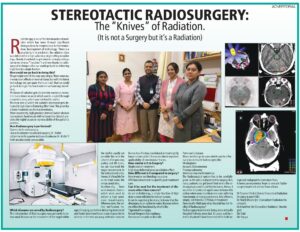Bone Cancer
What is bone cancer?
Bone cancer occurs when a tumor, or abnormal mass of tissue, forms in a bone. A tumor may be malignant, which means it’s growing aggressively and spreading to other parts of the body.
Types of bone cancer:
Primary bone cancers form directly in the bones or surrounding tissue, such as
cartilage.
Cancer can also spread, or metastasize, from another part of your body to bones. This is
known as secondary bone cancer that is more common than primary bone cancer.
Common types of primary bone cancers :
Osteosarcoma (Osteogenic sarcoma)
Osteosarcoma, or osteogenic sarcoma, generally affects children and adolescents, but it
can also occur in adults. It has a tendency to originate at the tips of the long bones
in the arms and legs.
Osteosarcoma may also start in the hips, shoulders, or other locations. It affects the
hard tissue that provides the outer layer of the bones.
Ewing’s sarcoma
Ewing’s sarcoma is a rare cancer that either begins in the soft tissues
surrounding the bones or directly in the bones of children and young adults.
The long bones of the body — such as the arms and legs — and the pelvis are commonly
affected.
Chondrosarcoma
It forms in the subchondral tissue, which is the tough connective tissue between your
bones. This is the second most common primary cancer involving the bones.
Chondrosarcoma may occur in the pelvis, thigh areas, and shoulders of older adults.
Multiple myeloma (MM)
Multiple myeloma is the most common type of bone cancer. It occurs when cancer cells
grow in the bone marrow and cause tumors in various bones. MM usually affects older
adults.
Among bone cancers, MM has one of the best prognosis.
Symptoms
Common symptoms :
- pain and swelling in the affected bones
- palpable hard mass in the long bones of the limbs
- feeling tired or fatigued
Less common symptoms :
- easily broken bones
- weight loss
Common Causes :
The cause of bone cancer isn’t exactly known, but there are certain factors that may
contribute to or increase a person’s chances of forming abnormal growths in the bone.
These include:
Abnormal cellular growth
Healthy cells continually divide and replace older cells. After completing this process
they die. Abnormal cells, however, continue living. They start forming masses of tissue
that turn into tumors.
Radiation therapy
Radiation therapy used to treat some other cancer may cause osteosarcoma in some people
who receive the treatment.
Risk Factors:
- family history of cancer, especially bone cancer
- Radiation treatment of that specific region in the past
- Paget’s disease,a condition that causes the bones to break down and then grow back abnormally
- Presence of multiple tumors in the cartilage connective
Stages of Bone cancer:
- Stage I : bone cancer hasn’t spread from the bone.
- Stage II : bone cancer hasn’t spread, but may become invasive, making it a threat to other tissue.
- Stage III : bone cancer has spread to one or more areas of the bone, and is invasive.
- Stage IV : bone cancer has spread to the tissues surrounding the bone, and to other organs such as the lungs or brain.
Diagnosis :
Following methods are used to determine the stage of bone cancers:
- Biopsy, which analyzes a small sample of tissue to diagnose cancer, should be done under guidance of a qualified oncosurgeon.
- Bone scan, which checks the condition of the bones
- imaging testing that includes X-rays, as well as MRI and CT scans, to get in-depth views of the bones’ structure
Treatment:
Treatment depends on:
- the stage of cancer
- the size and location of the tumor
- age and overall health of the patient.
Surgery
Surgery to remove and replace damaged bone is an option to stop cancers that spread
quickly. For extensive bone damage in the arms or legs, amputation may be needed.
Radiation therapy
Radiation has a role in post operative setting and Palliative settings.
Chemotherapy and other Medications :
chemotherapy drugs for Ewing’s tumpr,multiple myeloma pain medications to relieve
inflammation and discomfort bisphosphonates to help prevent bone loss and protect bone
structure
